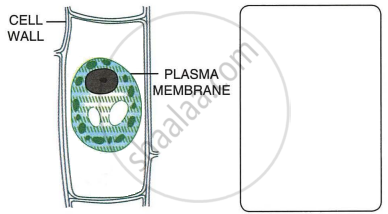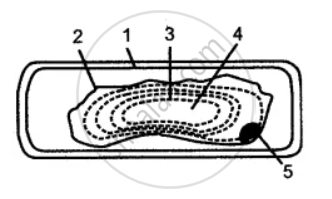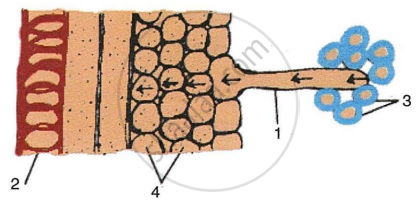Advertisements
Advertisements
प्रश्न
A plant cell may burst when :
पर्याय
Turgor pressure equalises wall pressure.
Turgor pressure exceeds wall pressure.
Wall pressure exceeds turgor pressure.
None of the above
उत्तर
The turgor pressure is the pressure that allows the cell to maintain the shape of the cell. When there is endosmosis, there is the entry of water into the cell. This increases turgor pressure. The wall pressure is always equal to the turgor pressure. When the turgor pressure will exceed beyond the wall pressure, the cell wall will burst.
Thus, the correct answer is option B.
APPEARS IN
संबंधित प्रश्न
Explain Turgor pressure
A leaf cell of a water plant was placed in a liquid other than pond water. After sometime, it assumed a shape as shown below:

- Give the term for the state of the cell it has acquired.
- Name the structure which acts as a selectively permeable membrane.
- Comment on the nature (tonicity) of the liquid surrounding the cell.
- Name any one feature of this plant cell which is not present in an animal cell.
- Redraw in the space provided, the diagram of the cell if it is soon placed in ordinary water for some time.
Differentiate between:
Turgid and Flaccid.
Differentiate between the following:
Plasmolysis and Deplasmolysis.
The below diagram represents a plant cell after being placed in a strong sugar solution. Guidelines 1 to 5 indicate the following:
1. Cell wall
2. Plasma membrane.
3. Protoplasm
4. Large vacuole
5. Nucleus
Study the diagram and answer the questions that follow :
(i) What is the state of the cell shown in the diagram?
(ii) Name the structure which acts as a selectively permeable membrane.
(iii) If the cell had been placed in distilled water instead of a strong sugar solution which features: would not have been present?
(iv) If the cell in the diagram possessed chloroplasts where would these be present?
(v) Name any one feature of this plant cell which is not present in animal cells.
Give Technical Term for the following.
A cell in a fully extended condition.
Excessive use of fertilisers in agricultural fields reduces the yield of crops. Justify the statement.
Addition of salt to pickles is a method of killing the bacteria by ______.
Give the equivalent term for the following:
Pressure exerted by the cell contents on the cell wall.
The figure given below is a diagrammatic representation of a part of the cross-section of the root in the root hair zone. Study the same and then answer the questions that follow:

- The parts labelled as 1, 2, 3 and 4 are:
- Root hair, Xylem vessel, Soil particles, Cortex respectively.
- Xylem vessel, Soil particles, Root hair, Cortex respectively.
- Root hair, Xylem vessel, Cortex, Soil particles respectively.
- Cortex, Soil particles, Xylem vessel, Root hair respectively.
- The process that enables the passage of water from soil into the root hair is:
- Diffusion
- Active transport
- Osmosis
- Passive absorption
- The kind of force which exists between a liquid and any surface is called as:
- Cohesive force
- Adhesive force
- Capillarity
- Suction force
- The kind of force between the same kind of liquid molecules is:
- Capillary force
- Transpirational pull
- Adhesive force
- Cohesive force
- Sometimes exudation of water occurs from the margin of the leaves in the early morning or night. It is termed as:
- Transpiration
- Guttation
- Bleeding
- Osmosis
